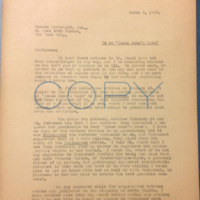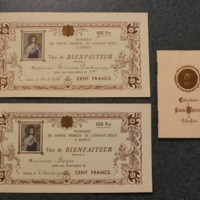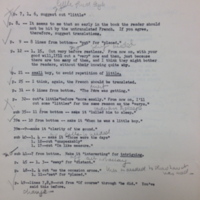Queen of Fiction : A Best Seller
From the mid-1930s until just before her death in 1970, Keyes wrote a string of best-selling novels, beginning with Honor Bright (1936) and ending with The Heritage (1968). Keyes’s dedication of Honor Bright reads: “To Genevieve Walsh Gudger, the noble daughter of a great father from a devoted friend of both.” The Washington Post’s reporter Jessie Ash Arndt noted that Eleanor Roosevelt attended a party celebrating the book’s launch [1]
The year before the publication of Honor Bright, Keyes’s 1933 novel, Senator Marlowe’s Daughter, became a bestseller in England. It was also the first of her novels to be published by Julian Messner and when the company celebrated its twenty-fifth anniversary in 1958 it reissued Senator Marlowe’s Daughter and The Great Tradition in one volume. On the same day, Messner also published Victorine, a novel set in Louisiana. By then Messner and Keyes had forged a fruitful relationship.
Newspaper reports about book-launching parties attended by famous people helped garner publicity for Keyes’s novels but Messner knew that other means were also necessary to lift books to the bestseller rank. In preparation of the publication of Came a Cavalier (1947), Messner launched a $25,000 advertising campaign that included posters and postcards. [2] The campaign was successful, with the novel selling over a million copies in 1948. [3] Keyes’s best-known novel, probably because it was the only one to make it to film (on television), Dinner at Antoine’s (1948), had sold a million and a half copies by 1954 and two and a half million by 1968. [4]
Popular success did not always mean positive press and the one cultural arena Keyes hoped to conquer, movies, remained outside her grasp. “To read a Keyes novel,” Robert Wernick wrote in 1959, “is to enter an enormous ballroom decorated with expensive good taste, where a number of generally kindly people (a few, however are positive swine) rotate in elegant costumes and whisper to each other interminable stories of family entanglements. It is never too clear just what is going on.” Keyes’s plots are murky, Wernick concluded, because “she has no plots.” Instead, she has “the ability to evoke a rich, full-flavored atmosphere of aristocratic living on a grand, complicated scale.” The problem with no plots, however, was serious. Stories that are so “uncorseted” meant that “no one in Hollywood has ever been able to tie them up into a movie script.” [5]
Whether it was because her novels lacked strong narrative arcs or for some other reason, Keyes’s books did not make it to the big screen even though her correspondence shows that Keyes attempted to bring that about. Keyes visited Mary Pickford, “America’s Sweetheart” and a co-founder of United Artists, in 1922; what they discussed is not documented but Keyes later reported that Mary Gray, who was hosting Keyes during her California visit, hoped that the big studios would be interested in her books. [6] On the same trip, Keyes met the screenwriter Frances Marion and she began a decades-long correspondence with Marion that included discussions of Keyes’s progress (or lack of progress) in turning her books into movies. Newspapers reported in 1938 and 1939 that Parts Unknown had been sold to RKO and Irene Dunne has been cast as the female lead. In 1944, it was reported that Michael Todd had acquired the rights to Crescent Carnival. Two years later, The River Road was purchased by RKO for a reputed $100,000. None were produced. [7] Keyes had better luck with radio. In the 1930s, “With a Senator’s Wife” could be listened to on WRC in the Washington, D.C. area and on WEEI in Boston. [8]
By 1950, Keyes was secure enough as a best-selling novelist to write her own account of what this meant. The Cost of a Best Seller begins with the story of her mother and husband’s opposition to her writing life and continues to count up the costs (“sometimes with bitterness,” according to one reviewer) that mounted as she continued to be true to what she called her “destiny.” [9] These costs are balanced, in not outweighed by the benefits, which include financial gains, travels, and an ability to participate in a world community.
Being a popular writer is very different from being a literary one. In 1950, Keyes told Harvey Breit, a book reviewer for the New York Times, “I have always been much more interested in being a woman of letters than a best seller author. I want still to turn out the kind of work I have always been interested in turning out – biography and travel sketches and verse.” [10] This aspiration led Keyes to continue writing the kinds of historical sketches that gave her writing career its start. In 1937, Keyes published Pioneering People in Northern New England and two years later her article, “My Aunt Nancy: A Lady Journalist of the Timid Fifties,” appeared in the National Historical Magazine. It was her developing interest in the Catholic religion, however, that led her to begin writing a different kind of historical biography. In 1937, Messner published Written in Heaven: the Life on Earth of the Little Flower of Lisieux and in 1940, a year after Keyes converted to Catholicism, The Sublime Shepherdess was released. More religious writings were to follow.
Notes:
1) Washington Post, December 18, 1936. ↵
2) Kirkus Reviews, October 24, 1947. ↵
3) Harry Hansen, “Two Best Sellers of 1948 Now Past Million Mark,” Chicago Daily Tribune, December 19, 1948. ↵
4) Kirkus Reviews, June 8, 1954; Boston Globe, June 9, 1968. ↵
5) Robert Wernick, “The Queens of Fiction,” Life, April 6, 1959, 139-152. ↵
6) All Flags Flying, 203. ↵
7) Washington Post, December 26, 1938; New York Times, June 5, 1939, February 9, 1944, November 22, 1946. ↵
8) Washington Post, February 24, 1932. ↵
9) Virginia Kirkus, “The Value of the Best Seller: An Appraisal of Frances Parkinson Keyes,” The English Journal, 40:6 (June 1951): 303-307, quote on 304. ↵
10) Harvey Breit, “Talk with Mrs. Keyes,” New York Times, December 10, 1950. ↵
Related Documents:



